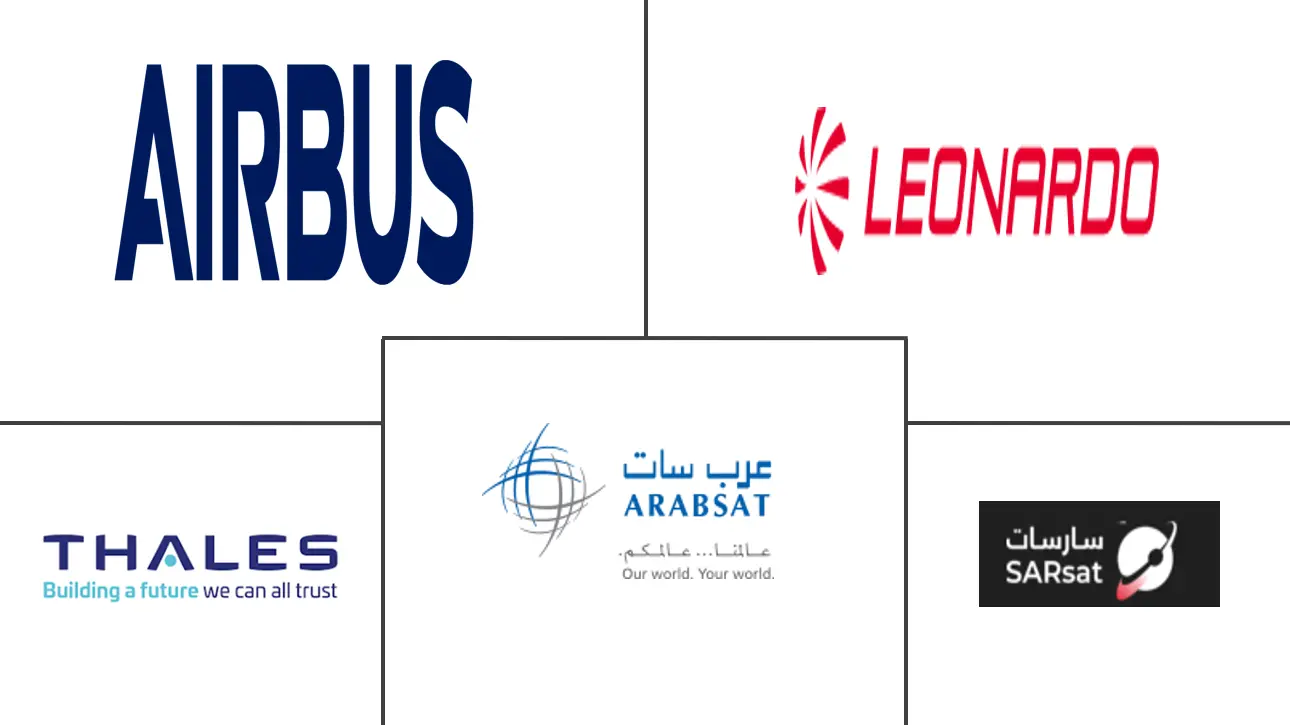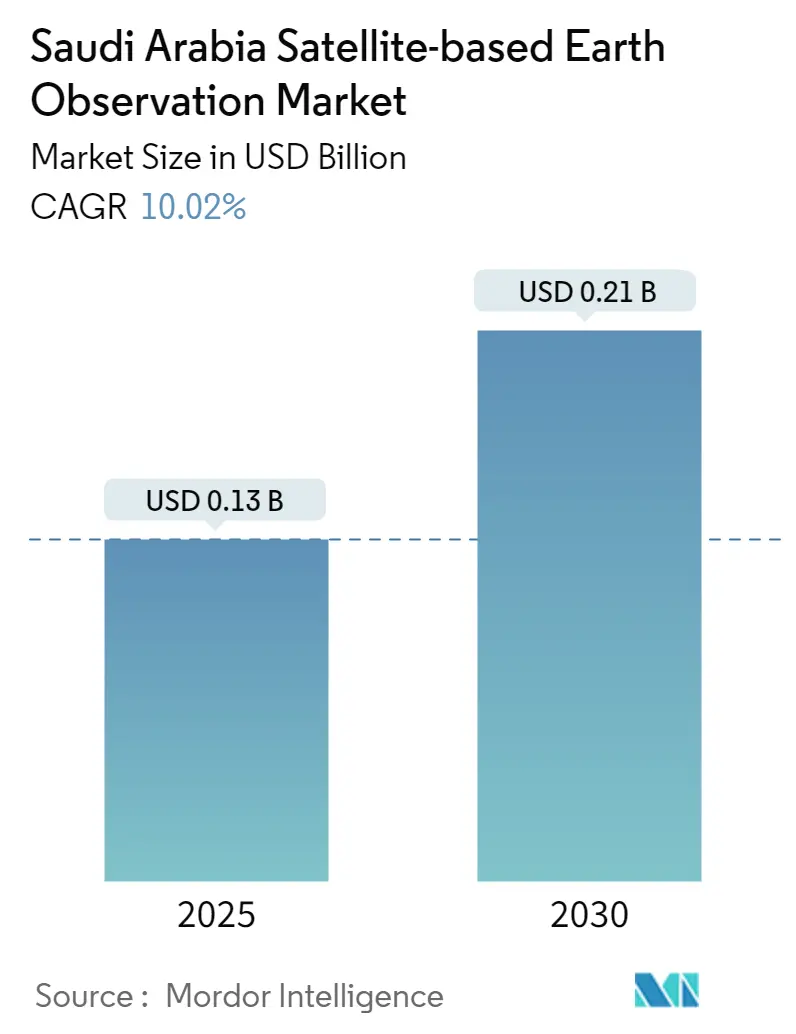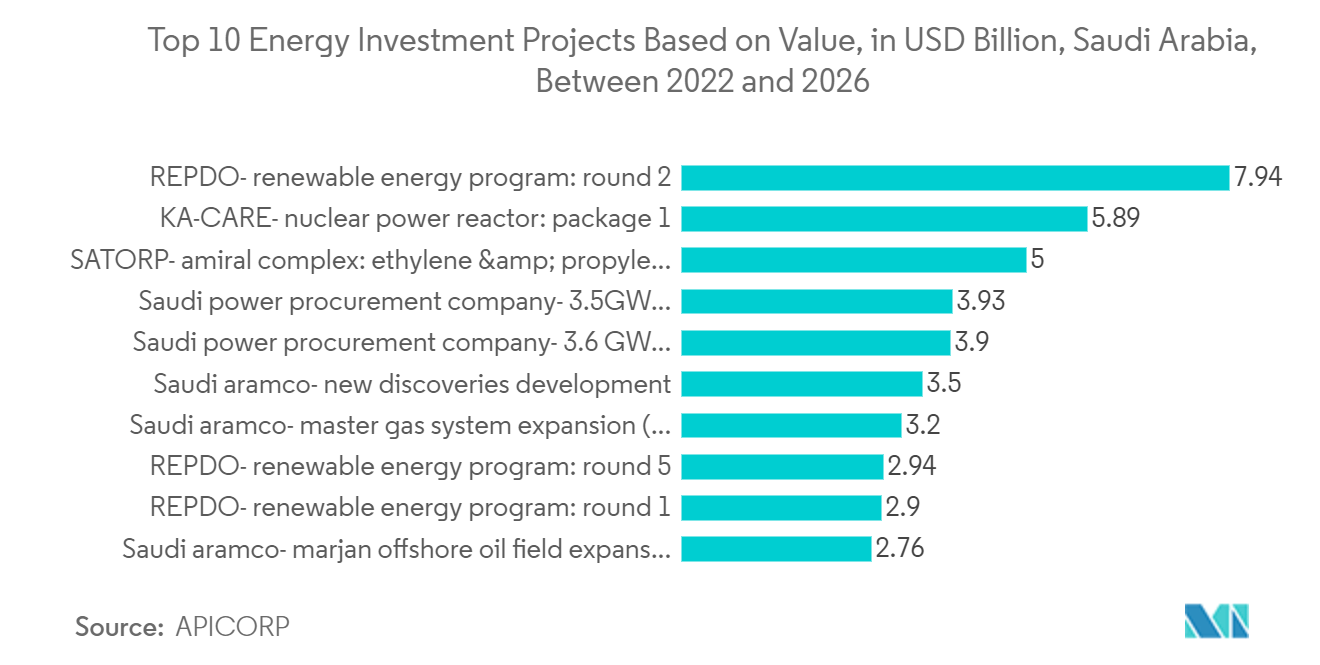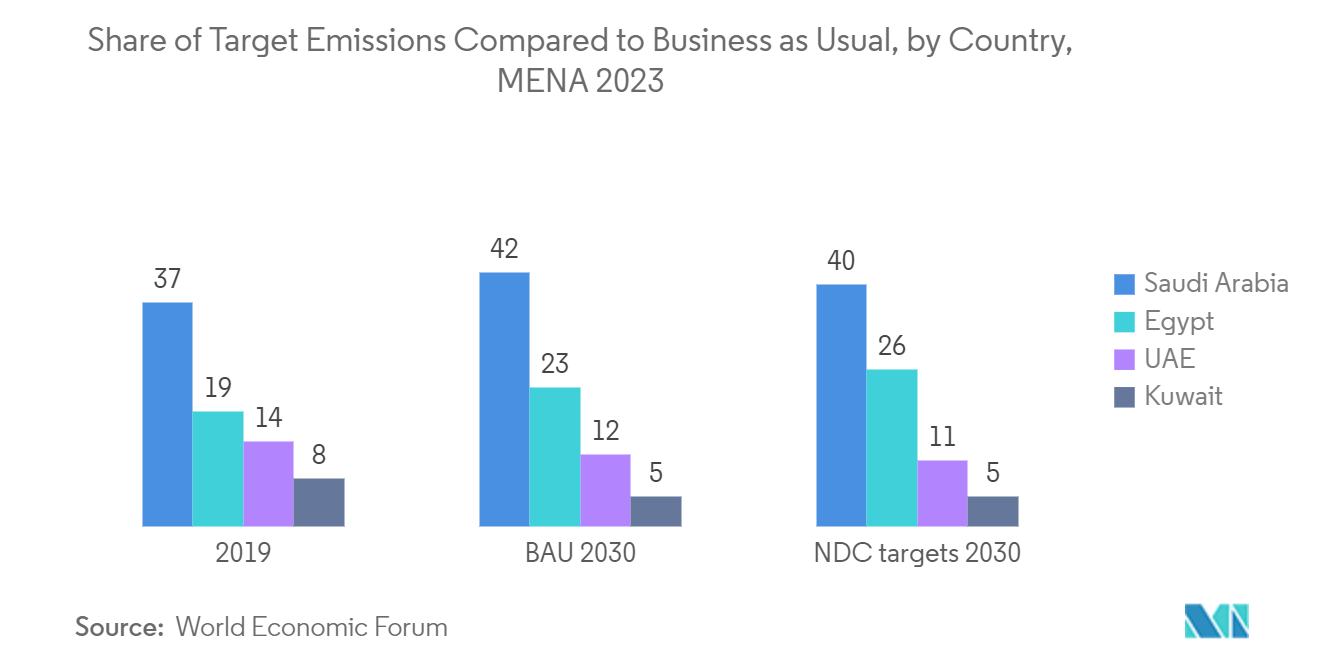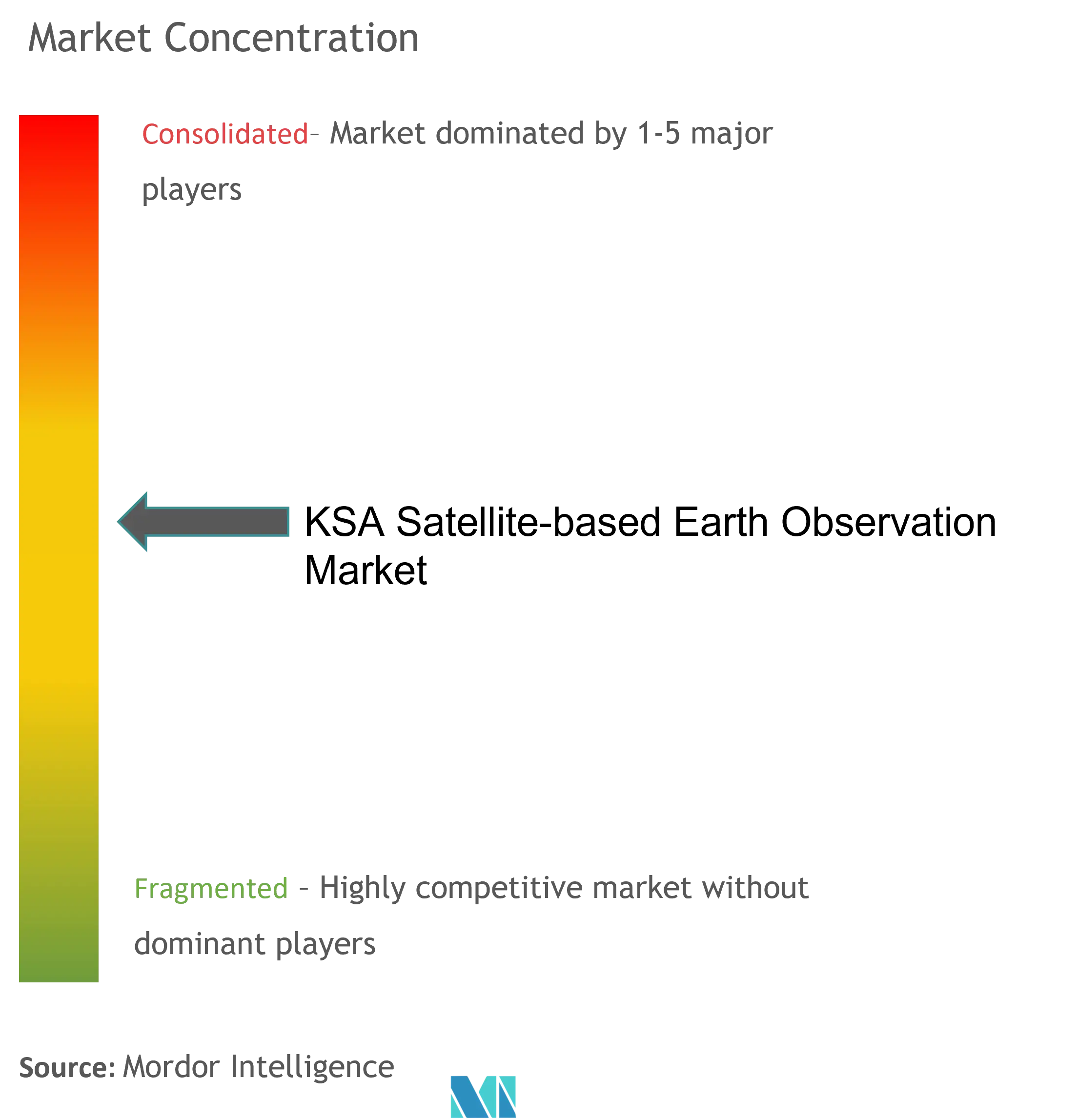Saudi Arabia Satellite-based Earth Observation Market Analysis
The Saudi Arabia Satellite-based Earth Observation Market size is estimated at USD 0.13 billion in 2025, and is expected to reach USD 0.21 billion by 2030, at a CAGR of 10.02% during the forecast period (2025-2030).
The KSA Satellite-based earth observation market is analyzed to grow at a substantial rate in the coming years owing to the supportive regulatory framework to promote and expand new players in space sector, Kingdom's interest in advancing its space ecosystem coupled with the growing demand from various end-user sectors.
- The KSA satellite-based earth observation market is in the developing stage, and the market is analyzed to witness substantial growth in the coming years owing to the Saudi Space Commission's ambitious plans to develop the local space economy. Moreover, the Kingdom recently restructured its regulatory framework for non-terrestrial networks (NTN), including the promotion and entry of global satellite operators.
- Further, the Kingdom of Saudi Arabia's Communications, Space and Technology Commission (CST) will provide landing/operating rights to satellite operators who meet specific standards, such as delivering innovative satellite-based solutions and efficiently using spectrum to offer unique services in the Kingdom,
- Mporover, in accordance with its new national spectrum policy and Saudi Vision 2030. Such developments further boost the global presence of major global market vendors in KSA, which is likely to positively impact the studied market growth in the coming years.
- The Kingdom of Saudi Arabia is Seeking to achieve regional leadership in the fields of international space and contribute to the future development of this vital sector; Saudi Arabia is working on space technologies and systems through national and international cooperation in R & D programs, technology transfer, and localization. This is expected to create growth opportunities for the satellite-based earth observation market in the Kingdom over the forecast period.
- Moreover, the increasing earth observation activities, such as the launch of various earth observation satellites by The King Abdulaziz City for Science and Technology (KACST) in the past few years is further augmenting the growth of the studied market in the country. For instance, In the past, Saudi Arabia's King Abdulaziz City for Science and Technology (KACST) has developed and manufactured SaudiSat-5A and SaudiSat-5B earth observation satellites and continually developing and launching new earth observation satellites, thus driving the KSA market.
Saudi Arabia Satellite-based Earth Observation Market Trends
Energy and Raw Materials Segment is Anticipated to Grow at a Significant rate
- The energy and raw materials segment in the KSA satellite-based earth observation market is analyzed to grow significantly owing to the increasing investments in the energy sector coupled with various benefits associated with earth-observation data in the energy and raw materials sector throughout all the phases of energy production and supply, ranging from identifying reservoirs and sites to controlling and monitoring of the distribution networks across the country.
- Moreover, the upcoming high-value energy projects in the country further drive the demand for satellite-based earth observation solutions to get the maximum output, thus driving the studied market growth in the coming years. For instance, according to the data from the APICORP, Between 2022 and 2026, the REPDO-renewable energy program (round 2) had the highest value in Saudi Arabia, amounting to nearly USD eight billion. Moreover, the value of the Saudi Aramco Marjan offshore oil field expansion project was approximately USD 2.7 billion.
- In March 2023, the Ministry of Energy, Saudi Arabia, announced that the country is now the world's leader in renewable energy production growth indicators in 2 years since Crown Prince Mohammed bin Salman launched Saudi Green Initiative (SGI). The country's renewable energy segment can benefit from Earth Observation's information. For instance, by providing weather, ocean, and sea status forecasts, EO helps plan and optimize operations during the construction and maintenance phases.
- Further, under Saudi Vision 2030, the country plans to generate 50% of its electricity from renewables and the other half from gas. This is expected to provide substantial growth opportunities for the Earth observation market as EO lends itself very well to site selection, planning, and monitoring for raw materials and renewable energy because many sites are being developed in increasingly isolated parts of the world.
Rising Demand for the Environmental Monitoring
- The growing environmental issues across the country are driving the demand for earth observation satellites for environmental monitoring.
- Saudi Vision 2030 is a sustainable vision for the future of Saudi Arabia, with sustainability at the core, from policy development and investment to planning and infrastructure. Further, Saudi Arabia contributes to the immense environmental impacts associated with oil drilling as it is the biggest oil exporter in OPEC. Such factors are further analyzed to grow the investments in environmental monitoring, which is expected to drive the demand for satellite-based earth observation solutions in the Kingdom in the coming years.
- Further, the country is leveraging earth observation data from earth observation satellites, namely Saudisat 5A and Saudisat 5B, to better understand how to mitigate global warming. The data enables the monitoring and modeling of the Earth's climate system, helping the country to make predictions. Satellite data from Earth Observation Satellites (EOS) provide information on greenhouse gas (GHG) emissions, the environmental changes from deforestation, melting ice, carbon dioxide levels, and the rise of sea levels, to name just a few areas.
- The increasing demand for environmental monitoring in the region propelled the market for satellite-based earth observation solutions in the country, and the government has launched earth observation satellites to gain Earth observation data that can help advance Vision 2030 goals, especially those related to protecting and restoring the environment. For instance, King Abdullah University of Science and Technology (KAUST) recently launched a Cubesat satellite to collect high-resolution and high-quality data across global coastal, terrestrial, and ocean ecosystems to help the country observe and characterize its unique natural resources.
Saudi Arabia Satellite-based Earth Observation Industry Overview
The Spain Satellite-based Earth Observation market is moderately consolidated with the presence of significant market players such as Arabsat, Airbus, etc., holding a significant market share. The market vendors are indulging in partnership and acquisition activities to increase their market share and presence. Additionally, new market players are entering the Saudi market, which is analyzed to grow the competitive rivalry in the coming years.
- May 2023 - Arabsat signed a Memorandum of Understanding (MoU) with Loft Orbital (Loft) to partner on the mission definition for future infrastructure in low earth orbit (LEO). Both firms will collaborate to build the infrastructure required to meet the needs of Arabsat's diverse client segments. Arabsat intends to use Loft's space infrastructure platform to provide earth observation services to all 22 Arab League member countries. This will enable the creation of dependable applications in agriculture, transportation and logistics, border and maritime monitoring, and environmental protection.
Saudi Arabia Satellite-based Earth Observation Market Leaders
-
Arabsat
-
Airbus
-
Leonardo S.p.A.
-
SARsat Arabia
-
Thales
- *Disclaimer: Major Players sorted in no particular order
Saudi Arabia Satellite-based Earth Observation Market News
- April 2023 - King Abdullah University of Science and Technology (KAUST) successfully launched a Cubesat satellite with its partner Spire Global on the SpaceX Transporter-7 mission from Vandenberg Space Force Base in the US. The satellite's mission is to capture high-quality, high-resolution data from worldwide terrestrial, coastal, and ocean ecosystems to assist Saudi Arabia in observing and characterizing its unique natural resources. Aside from improving Earth observation capabilities, the satellite will produce data to aid in advancing Vision 2030 goals, particularly those connected to environmental protection and restoration.
- March 2023 - AALTO HAPS signed a memorandum of understanding (MoU) with stc Group on the introduction of HAPS-based solutions to the Kingdom of Saudi Arabia. The company's solutions will enable stc to expand its geographical coverage to rural and distant locations that are currently unconnected. Furthermore, HAPS solutions can be utilized to supplement coverage during crucial events and can be swiftly and readily deployed in the event of a natural disaster. AALTO HAPS is an Airbus company that delivers mobile connection, platform mobility, earth observation, and government applications from its stratospheric Zephyr solar-powered aircraft.
Saudi Arabia Satellite-based Earth Observation Industry Segmentation
Satellite-based earth observation is done with the help of satellites orbiting around the planet to view and identify environmental changes, map making, etc. The satellite-based earth observation technology captures and stores information from satellites relating to the physical, biological, and chemical compositions of the Earth for monitoring, surveillance, and decision-making in various verticals, such as defense and intelligence, infrastructure and engineering, natural resource management, energy and power, and disaster management.
The KSA satellite-based earth observation market is segmented by type (earth observation data, value added services), by satellite orbit (low earth orbit, medium earth orbit, geostationary orbit), and by end-use(urban development and cultural heritage, agriculture, climate services, energy and raw materials, infrastructure). The market sizes and forecasts are provided in terms of value (USD) for all the above segments.
| By Type | Earth Observation Data |
| Value Added Services | |
| By Satellite Orbit | Low Earth Orbit |
| Medium Earth Orbit | |
| Geostationary Orbit | |
| By End-use | Urban Development and Cultural Heritage |
| Agriculture | |
| Climate Services | |
| Energy and Raw Materials | |
| Infrastructure | |
| Others |
Saudi Arabia Satellite-based Earth Observation Market Market Research Faqs
How big is the Saudi Arabia Satellite-based Earth Observation Market ?
The Saudi Arabia Satellite-based Earth Observation Market size is expected to reach USD 0.13 billion in 2025 and grow at a CAGR of 10.02% to reach USD 0.21 billion by 2030.
What is the current Saudi Arabia Satellite-based Earth Observation Market size?
In 2025, the Saudi Arabia Satellite-based Earth Observation Market size is expected to reach USD 0.13 billion.
Who are the key players in Saudi Arabia Satellite-based Earth Observation Market ?
Arabsat, Airbus, Leonardo S.p.A., SARsat Arabia and Thales are the major companies operating in the Saudi Arabia Satellite-based Earth Observation Market .
What years does this Saudi Arabia Satellite-based Earth Observation Market cover, and what was the market size in 2024?
In 2024, the Saudi Arabia Satellite-based Earth Observation Market size was estimated at USD 0.12 billion. The report covers the Saudi Arabia Satellite-based Earth Observation Market historical market size for years: 2019, 2020, 2021, 2022, 2023 and 2024. The report also forecasts the Saudi Arabia Satellite-based Earth Observation Market size for years: 2025, 2026, 2027, 2028, 2029 and 2030.
Our Best Selling Reports
Saudi Arabia Satellite-based Earth Observation Market Industry Report
Statistics for the 2025 Saudi Arabia Satellite-based Earth Observation market share, size and revenue growth rate, created by Mordor Intelligence™ Industry Reports. Saudi Arabia Satellite-based Earth Observation analysis includes a market forecast outlook for 2025 to 2030 and historical overview. Get a sample of this industry analysis as a free report PDF download.

